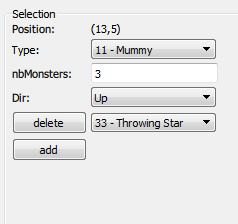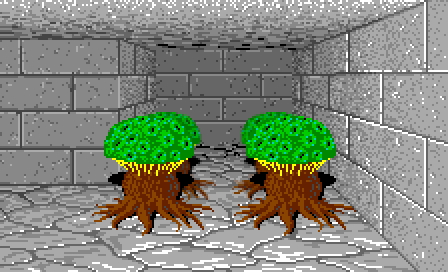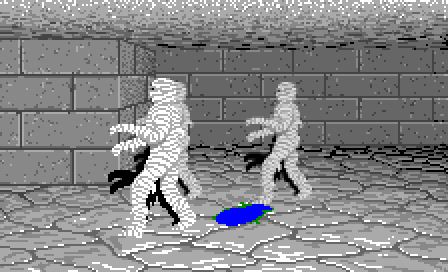Downloads
Executable for the map editor (Windows 32bits)
Executable for the game (Windows 32bits)
Before you try to compile the code go to the "Projects" tab on the left menu, select the "Run" settings for your kit,
and set the "Working directory" to the path of "editor\data" for the editor or "game\data" for the game.
Parameters

<!-- 01 Giant Scorpion -->
<monster name = "MONSTER01">
[...]
<param type="int">nbMonsters</param>
<param type="enum" values="Up;Down;Left;Right">Dir</param>
<param type="stack"/>
</monster>
<!-- 02 Swamp Slime -->
<monster name = "MONSTER02">
[...]
<param type="int">nbMonsters</param>
<param type="enum" values="Up;Down;Left;Right">Dir</param>
<param type="stack"/>
</monster>
"Dir" is the direction the group is facing at the beginning.
And the objects stack contains the objects that will be dropped on the ground when all the monsters of the group
are killed.
These stacks will be stored along with the others.
As we used WallSideMax for the stacks in the walls, we will use another value to differentiate the monsters' stacks.
enum EWallSide
{
eWallSideUp = 0,
eWallSideDown,
eWallSideLeft,
eWallSideRight,
eWallSideMax
};
#define eWallSideMonster (EWallSide)(eWallSideMax + 1)
with that.
Loading and initializing the monsters
void CMonsters::readMonstersDB()
{
QDomDocument doc;
QFile f("databases/monsters.xml");
f.open(QIODevice::ReadOnly);
doc.setContent(&f);
f.close();
QDomElement root = doc.documentElement();
QDomNode monsterNode = root.firstChild();
while(!monsterNode.isNull())
{
if (monsterNode.isElement())
{
QDomElement monster = monsterNode.toElement();
std::vector<CParamType> paramsTypesList;
if (monster.tagName() == "monster")
{
QDomElement monsterInfo = monster.firstChild().toElement();
SMonsterData monsterData;
while(!monsterInfo.isNull())
{
if (monsterInfo.tagName() == "img_front")
{
monsterData.frontImage = QString("gfx/3DView/monsters/") + monsterInfo.text();
}
else if (monsterInfo.tagName() == "img_side")
{
monsterData.sideImage = QString("gfx/3DView/monsters/") + monsterInfo.text();
}
else if (monsterInfo.tagName() == "img_back")
{
monsterData.backImage = QString("gfx/3DView/monsters/") + monsterInfo.text();
}
else if (monsterInfo.tagName() == "img_attack")
{
monsterData.attackImage = QString("gfx/3DView/monsters/") + monsterInfo.text();
}
else if (monsterInfo.tagName() == "param")
{
QString paramType = monsterInfo.attribute("type");
CParamType newParamType;
if (paramType == "int")
{
newParamType.mType = eParamInt;
newParamType.mName = monsterInfo.text();
paramsTypesList.push_back(newParamType);
}
else if (paramType == "enum")
{
newParamType.mType = eParamEnum;
newParamType.mName = monsterInfo.text();
newParamType.mValues = monsterInfo.attribute("values").split(";");
paramsTypesList.push_back(newParamType);
}
else if (paramType == "stack")
{
newParamType.mType = eParamStack;
paramsTypesList.push_back(newParamType);
}
}
monsterInfo = monsterInfo.nextSibling().toElement();
}
CMap::mMonstersParams.push_back(paramsTypesList);
monstersDatas.push_back(monsterData);
}
}
monsterNode = monsterNode.nextSibling();
}
}
The parameters are stored in the CMap class, as for the other elements - the tiles, the walls, etc.
And the group images for each type of monsters are stored in the monstersDatas list:
class CMonsters
{
public:
[...]
struct SMonsterData
{
QString frontImage;
QString sideImage;
QString backImage;
QString attackImage;
};
[...]
private:
[...]
std::vector<SMonsterData> monstersDatas;
};
class CMonsters
{
public:
[...]
struct SMonsterGroup
{
SMonster monsters[4];
EMonsterDir dir;
};
[...]
private:
[...]
std::vector<SMonsterGroup> monsterGroups;
};
will initialize all monsters separately.
class CMonsters
{
public:
enum EMonsterPos
{
eMonsterPosNone, // empty monster
eMonsterPosNorthWest,
eMonsterPosNorthEast,
eMonsterPosSouthWest,
eMonsterPosSouthEast,
eMonsterPosCenter
};
enum EMonsterDir
{
eMonsterDirUp,
eMonsterDirDown,
eMonsterDirLeft,
eMonsterDirRight
};
struct SMonsterData
{
QString frontImage;
QString sideImage;
QString backImage;
QString attackImage;
};
struct SMonster
{
EMonsterPos pos;
EMonsterDir dir;
int life;
};
Here is the init() function:
void CMonsters::init()
{
for (size_t i = 0; i < map.mMonsterGroups.size(); ++i)
{
CMonsterGroup& mapGroup = map.mMonsterGroups[i];
SMonsterGroup group;
int nbMonsters = mapGroup.getIntParam("nbMonsters");
group.dir = (EMonsterDir)mapGroup.getEnumParam("Dir");
for (int j = 0; j < nbMonsters; j++)
group.monsters[j].dir = group.dir;
if (nbMonsters == 1)
{
group.monsters[0].pos = eMonsterPosCenter;
group.monsters[0].life = 3;
for (int j = 1; j < 4; j++)
{
group.monsters[j].pos = eMonsterPosNone;
group.monsters[j].life = 0;
}
}
else
{
// monster positions for a given direction
static const EMonsterPos startingPos[4][4] =
{
{eMonsterPosNorthWest, eMonsterPosNorthEast, eMonsterPosSouthWest, eMonsterPosSouthEast}, // up
{eMonsterPosSouthEast, eMonsterPosSouthWest, eMonsterPosNorthEast, eMonsterPosNorthWest}, // down
{eMonsterPosNorthWest, eMonsterPosSouthWest, eMonsterPosNorthEast, eMonsterPosSouthEast}, // left
{eMonsterPosSouthEast, eMonsterPosNorthEast, eMonsterPosSouthWest, eMonsterPosNorthWest} // right
};
for (int j = 0; j < 4; j++)
{
if (j < nbMonsters)
{
group.monsters[j].pos = startingPos[group.dir][j];
group.monsters[j].life = 3;
}
else
{
group.monsters[j].pos = eMonsterPosNone;
group.monsters[j].life = 0;
}
}
}
monsterGroups.push_back(group);
}
}
Drawing the monsters


Monsters are drawn in the CMonsters::draw() function.
First we will have a for loop because we need to do 3 passes to draw the monsters following the perspective.
We will first draw the back row monsters, then the center ones, and finally the front row.
void CMonsters::draw(QImage* image, CVec2 mapPos, CVec2 tablePos)
{
if (tablePos.y == WALL_TABLE_HEIGHT - 1)
return;
int groupIndex = map.findMonsterGroupIndex(mapPos);
if (groupIndex != -1)
{
CMonsterGroup& mapGroup = map.mMonsterGroups[groupIndex];
SMonsterGroup& group = monsterGroups[groupIndex];
// monster positions depending on the player direction
static const float monsterPosDir[4][5][2] =
{
// NW NE SW SE C
{{0.0, 0.0}, {1.0, 0.0}, {0.0, 1.0}, {1.0, 1.0}, {0.5, 0.5}}, // up
{{1.0, 0.0}, {1.0, 1.0}, {0.0, 0.0}, {0.0, 1.0}, {0.5, 0.5}}, // left
{{1.0, 1.0}, {0.0, 1.0}, {1.0, 0.0}, {0.0, 0.0}, {0.5, 0.5}}, // down
{{0.0, 1.0}, {0.0, 0.0}, {1.0, 1.0}, {1.0, 0.0}, {0.5, 0.5}} // right
};
// monster dir depending on the player direction
static const EMonsterDir monsterDirDir[4][4] =
{
{eMonsterDirUp, eMonsterDirDown, eMonsterDirLeft, eMonsterDirRight}, // up
{eMonsterDirRight, eMonsterDirLeft, eMonsterDirUp, eMonsterDirDown}, // left
{eMonsterDirDown, eMonsterDirUp, eMonsterDirRight, eMonsterDirLeft}, // down
{eMonsterDirLeft, eMonsterDirRight, eMonsterDirDown, eMonsterDirUp} // right
};
// we draw the back row monsters before the front ones
for (int row = 0; row < 3; ++row)
{
for (int i = 0; i < 4; ++i)
{
SMonster& monster = group.monsters[i];
if (monster.pos != eMonsterPosNone)
{
// relative direction
EMonsterDir tableDir = monsterDirDir[player.dir][monster.dir];
// sprite
int type = mapGroup.getType();
QString spriteName;
bool flip = false;
if (tableDir == eMonsterDirDown)
{
spriteName = monstersDatas[type].frontImage;
}
else if (tableDir == eMonsterDirUp)
{
spriteName = monstersDatas[type].backImage;
if (spriteName.isEmpty() == true)
spriteName = monstersDatas[type].frontImage;
}
else
{
spriteName = monstersDatas[type].sideImage;
if (spriteName.isEmpty() == true)
spriteName = monstersDatas[type].frontImage;
else if (tableDir == eMonsterDirLeft)
flip = true;
}
if (monsterPosDir[player.dir][monster.pos - eMonsterPosNorthWest][1] == (float)row / 2.0)
{
// table pos
float tablePosX = tablePos.x * 2 + monsterPosDir[player.dir][monster.pos - eMonsterPosNorthWest][0];
float tablePosY = tablePos.y * 2 + monsterPosDir[player.dir][monster.pos - eMonsterPosNorthWest][1];
// screen pos
QImage sprite = fileCache.getImage(spriteName.toStdString());
CVec2 pos = getMonsterPos(tablePosX, tablePosY);
// compute the scale based on the reference position (the nearest)
CVec2 pos0, pos1;
float scale;
pos0 = getMonsterPos(WALL_TABLE_WIDTH, (WALL_TABLE_HEIGHT - 1) * 2 + 1);
pos1 = getMonsterPos(WALL_TABLE_WIDTH, tablePosY);
scale = 2.37 * (float)(pos1.x - 112) / (float)(pos0.x - 112);
// scale the monster in a temporary image
QImage scaledMonster(sprite.size() * scale, QImage::Format_ARGB32);
scaledMonster.fill(TRANSPARENT);
graph2D.drawImageScaled(&scaledMonster, CVec2(), sprite, scale);
// darken the monster based on it's distance
float shadow = ((WALL_TABLE_HEIGHT - 1) * 2 - tablePosY - 1) * 0.13f;
graph2D.darken(&scaledMonster, shadow);
// draw the monster (pos relative to its feets)
pos.x -= scaledMonster.width() / 2;
pos.y -= scaledMonster.height() - 9 * scale;
graph2D.drawImage(image, pos, scaledMonster, 0, flip, QRect(0, 33, MAINVIEW_WIDTH, MAINVIEW_HEIGHT));
}
}
}
}
}
}